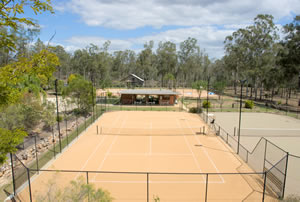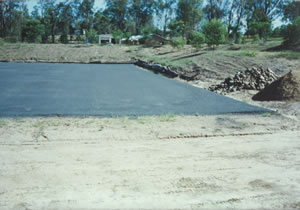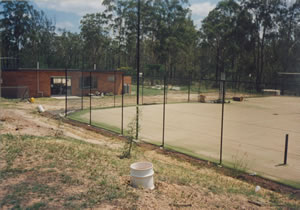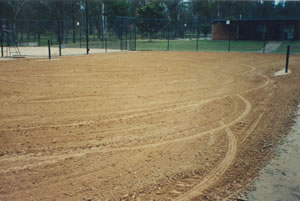History of Tall Gums Sports Centre
 Why clay courts at Tall Gums.
Why clay courts at Tall Gums.
The choice of court surface for the centre when it was originally built was relatively simple. We wanted a surface that suited all levels of player, developed the best players, was fun and interesting to play on and looked after players’ physical well being as much as possible.
The obvious surface choice was CLAY.
Clay courts can take many forms depending on the country (or State) of origin. Many of Australia’s great players of the past learned to play on ‘sandy loam’ or ant bed courts. It has been stated that 70% of the world learns to play on clay. More significantly, in 2009 Lee Tennis Court Products (USA) came up with “a best estimate based on available information” which used information from 1973 to 2008 which concluded that 88% of the top 10 players (since rankings were kept) learned to play on clay compared to 12% on hardcourt. That is 91 of the 103 men who have reached top 10 ranking grew up on clay courts. (See Lee Tennis page later on).
 So why did Australia move away from clay courts?
So why did Australia move away from clay courts?
Clay courts are very expensive to install and the continuing maintenance is both costly and labour intensive. Australia, and particularly Queensland’s harsh climate makes court maintenance difficult at best. Relatively high temperatures means that courts require large amounts of water to keep the courts rolled correctly, heavy storms wash away the sand top on the surface as does strong winds, heavy continual rain keeps the courts wet for extended periods of time and washes away the actual surface. Is it all worth it?
YES !!!!!!
Clay courts benefits
- There is no abrasive surface to prematurely wear out shoes, balls and racquets
- Easy on feet and legs
- Surface reacts effectively to spin put on the ball
- Appropriate for beginners, intermediate, advanced, elite & senior level players
- Patience in play – mental toughness
 Players learn how to develop points/tactics
Players learn how to develop points/tactics- Enhances the development of players’ footwork, balance and dexterity
- Strengthens muscles while limiting injuries
- Teaches players to develop the ability to use varied play and tactics and an all court playing style
- Generally develops the skills necessary to succeed on other than clay court surfaces
- It’s just fun – for the true tennis enthusiast
The Australian tennis fraternity has scrambled over the last few years to install clay courts throughout the country. Tall Gums courts are classed as Real Clay – non porous which we believe, and time has proven to be, the most suitable for Queensland’s climate. There is a wide variety of clay, loam and grit type courts all with different playing and maintenance characteristics. One of the most popular worldwide courts is the ‘red clay’ type. Courts described as ‘red clay’ are usually made of crushed brick and/or tile and are classed as porous clay courts. These courts require an enormous amount of water to be correctly maintained and are required to be played on ‘wet’ (about 15% to 20% moisture content). Adverse weather conditions have a more detrimental effect on red clay courts than non porous. The fine red ‘dust’ of the surface stains clothes, socks and shoes. The pace is considered slow and suits a limited number of players. Other types of these surfaces include sandy loam, ant bed, granite/duco, en-tout-cas, Har-tru and a multitude of variations. All these courts were considered when choosing the surface for Tall Gums courts.
 Our courts suit a greater variety of player, therefore our choice of the type of clay we installed at Tall Gums. Our clay courts are made up of selected clays, clay binders and sandstone combined in specific ratios.
Our courts suit a greater variety of player, therefore our choice of the type of clay we installed at Tall Gums. Our clay courts are made up of selected clays, clay binders and sandstone combined in specific ratios.
Tall Gums courts are watered from specially installed dams that are filled by rain water and run off. We continually ‘cut’ the surface of our courts during the maintenance process. Well maintained clay courts are generally ‘flatter’ and have a more even surface than other types of surfaces.
The uninitiated or inexperienced clay court player may complain of ‘bad bounces’ on occasions. These ‘bad bounces’ are usually the result of the spin on the ball, which alters the direction of the ball when it strikes the ‘sand top’ of the surface – a characteristic of clay courts that they accept and react to a players’ spin on the ball.
There is a misconception in the minds of some (once again the uninitiated clay players) that clay courts are slippery. Properly prepared clay courts allow players wearing the correct tennis shoes to controllably slide across the surface with the aid of the ‘sand top’.
For more information on tennis shoes, go to ‘shoes’ on this website.
Clay courts are a prized possession to the tennis enthusiast, a real player’s court, a top choice for the training of the world’s best players as well as the weekend warrior, social and senior player.
We wanted a top quality surface for our centre. You’ve got it so please enjoy it.
Contact Us Details
109 Haigslea-Amberley Road,
WALLOON, QLD, 4306
p: (07) 5464-5599
Click here to email us.
